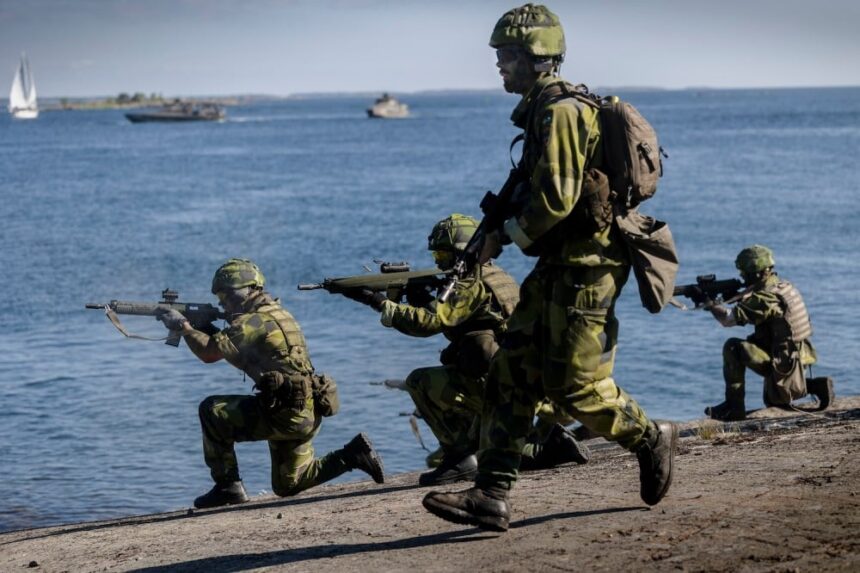Summary by Geopolist | Istanbul Center for Geopolitics
This summer, Finland has experienced a series of break-ins at its water towers and treatment plants, with intruders stealing nothing but potentially scouting for future attacks or causing public anxiety about water safety. The incidents began in Porvoo and Sipoo, two towns on Finland’s southern coast, and by mid-July, 11 break-in attempts had been reported. These attacks are seen as part of a broader pattern of nonmilitary aggression, often attributed to Russia, aimed at destabilizing its neighbors.
Although no suspects have been apprehended, and the intruders did not reach sensitive parts of the water facilities, the string of attacks has prompted Finnish authorities to bolster security measures, including increased fencing and surveillance. Experts, such as retired Lt. Gen. Arto Raty and retired Maj. Gen. Pekka Toveri, suggest that these actions are consistent with Russia’s gray-zone warfare tactics, which seek to create fear and strain resources without engaging in open conflict.
Russia’s interest in harming Finnish infrastructure and creating a sense of insecurity among Finns aligns with its historical reactions to NATO-related developments. Despite no direct evidence linking the Kremlin to these specific break-ins, the pattern of such aggressive tactics and the broader geopolitical context suggest a possible connection.
These incidents are part of a larger trend of targeting critical infrastructure, with similar attacks reported in other Western countries. For example, Russia has been linked to cyberattacks on U.S. water facilities, and other state actors like China and Iran have also been implicated in attempts to disable critical infrastructure in the United States.
In summary, while Finnish authorities are enhancing security and investigating these break-ins, the broader implications highlight the ongoing threat of hybrid warfare and the need for vigilance in protecting critical infrastructure from such covert attacks.
Read more below.
Is Russia Trying to Poison Finland’s Water?
This summer, mysterious intruders have been breaking into Finnish water towers and treatment plants. They’ve stolen nothing, which is unsurprising, since there would be little to steal. But there are other reasons people might want to break into water treatment plants: to scout them out for future attacks—or to cause the public to worry about the safety of the water in their taps. By disabling water treatment or adding a contaminant, an intruder could turn the life-giving liquid into a source of disease.
This summer, mysterious intruders have been breaking into Finnish water towers and treatment plants. They’ve stolen nothing, which is unsurprising, since there would be little to steal. But there are other reasons people might want to break into water treatment plants: to scout them out for future attacks—or to cause the public to worry about the safety of the water in their taps. By disabling water treatment or adding a contaminant, an intruder could turn the life-giving liquid into a source of disease.
So far, the Finnish authorities have not apprehended any suspects. The break-in campaign, though, is a prime example of the nonmilitary aggression that Russia has perfected. So is the coordinated sabotage that brought down French rail lines just as the Olympic Games were about to begin and only days after French police arrested a Russian national in a suspected plot to cause “destabilization” during the Games.
The water attacks in Finland began in Porvoo, a town on the southern coast, where authorities reported that someone had tried to break into the town’s water tower twice. Then Sipoo, near Helsinki, also on Finland’s southern coast, reported break-in attempts at its water plant, too. As in Porvoo, the attackers had targeted the plant two nights in a row. Finland’s southern coast is ordinarily rather quiet, but then again, its immediate neighbor is the Gulf of Finland, the passageway for ships going to and from St. Petersburg. One can never really be sure who is sailing past.
By mid-July, there had been 11 break-in attempts into Finnish water towers and treatment plants. “The break-ins reported this far have not been serious ones and not targeted against the most critical sites, which are more heavily secured, but the worrying thing is that the number of break-in has increased at this very moment,” said retired Lt. Gen. Arto Raty, whose military roles included overseeing Finland’s famous National Defense Course, in which leaders from all parts of society learn about threats to the country. (Raty now works in the private sector.)
The intruders didn’t reach any sensitive parts in the water plants and towers. But with such a noticeable string of attacks having taken place within just a few weeks, Finnish authorities must prepare for more. Several city councils have already decided to strengthen security around their water facilities, starting with more fences and more camera surveillance.
Authorities are also asking: Who would have an interest in breaking into Finnish water plants? So far, they haven’t apprehended anyone or publicly identified a suspect. The intruders, though, are unlikely to have been ordinary criminals. “These are not the sort of break-ins criminals would commit,” said retired Maj. Gen. Pekka Toveri, a former chief of Finnish military intelligence who is now a member of the European Parliament.
Indeed, thieves know that it’s hard to reach the sensitive parts of water facilities, and at any rate, expensive technology would be easier to steal elsewhere. One might suspect environmental extremists—but they stage highly public protests, not break-ins under the cover of darkness, and not even the most fanatical environmental extremist would think it a good idea to attack water sources. Terrorists, too, go for attacks that create maximum publicity, and no known terrorist groups have a beef with Finnish operators of critical national infrastructure.
One actor, though, has an interest in frightening Finns: the Kremlin. “The water treatment companies have said that the break-ins are not a normal situation, and that’s making people worried,” Toveri said. “And one goal of Russia’s gray-zone aggression is to create fear.” Raty added: “We have no evidence showing who is behind these actions, but naturally in speculations the finger is pointing to the east.”
Russia has a clear interest in harming Finnish critical national infrastructure—and in insinuating to the Finnish public that its infrastructure is unsafe. Before Finland and Sweden joined NATO, the Kremlin reacted to every suggestion along the lines of NATO accession by threatening unspecified consequences. When the two countries eventually joined, Russia’s armed forces were so bogged down in Ukraine that no so-called consequences took place.
That doesn’t mean that Russia has been idle. Even before the two countries’ NATO accession, the Kremlin was busy harming them and other Western countries in nonmilitary ways. Cyberattacks conducted or condoned by the Kremlin have wreaked havoc on American drivers (remember the Colonial Pipeline attack?), British hospitals, and countless others.
Last fall, Russia began bringing so many migrants to the Finnish border—with the purpose of overwhelming the Finnish authorities—that Helsinki had to shut the crossings altogether. Russia appears to have been involved in the mysterious sabotage of two undersea cables and one pipeline in Swedish, Finnish, and Estonian waters, also last fall: The suspected perpetrator, a Chinese container ship, had worked extensively with Russian authorities and sailed to and from Russian Baltic Sea ports before and after the incidents.
Russia can, in fact, keep coming up with new forms of aggression in the gray zone between war and peace because it faces no punishment for such aggression. Western countries are simply not going to respond eye for eye. Imagine if the governments of liberal democracies rounded up asylum-seekers and deposited them at the Russian border or allowed cybergangs based in the West to paralyze Russian hospitals.
Indeed, Russia can keep innovating in the gray zone using not just the government’s own personnel but all manner of freelancers, too. The coordinated sabotage of French high-speed rail lines is another example of gray-zone aggression; the sophistication of the attack suggests a state actor, but we may never know who did it.
Western governments can suspect a link between seemingly independent perpetrators and the Kremlin, but proving such links is virtually impossible. “Russia could just have paid some criminals to break into the water plants—we just don’t know,” Toveri said. “But what we do know is that the break-ins are tying up the authorities’ resources and creating fear among people.”
Finland is not the first country to see its water supply targeted. This May, Janet McCabe, the deputy administrator of the U.S. Environmental Protection Agency (EPA), warned that China, Russia, and Iran were “actively seeking the capability to disable U.S. critical infrastructure, including water and wastewater.” Last year, for example, the Iranian-linked hacker group Cyber Av3ngers took control of some of the water functions in the Pennsylvania town of Aliquippa, which forced the water authority to switch to manual operations.
This year, a Russian-linked so-called hacktivist tried to interfere with water operations in several Texas towns, CBS News reports. The Chinese state-sponsored cybergroup Volt Typhoon has been targeting U.S. water facilities and other critical services.
“Drinking water and wastewater systems are an attractive target for cyberattacks because they are a lifeline critical infrastructure sector but often lack the resources and technical capacity to adopt rigorous cybersecurity practices,” EPA Administrator Michael Regan and National Security Advisor Jake Sullivan warned in a letter in March. Indeed, the water authority of Aliquippa (population: 9,000) versus the government of Iran is hardly a match of equals. Nor is the Finnish municipality of Sipoo (population: 22,500) versus the Kremlin.
It will take a lot to stir up fear among Finns, who have seen their share of Russian overt and covert aggression. But the prospect of one’s water being harmed is bound to create worries; after all, not even an invasion is as dangerous as the widespread poisoning of drinking water. Regardless of whether Russia is connected to the break-ins into Finnish water plants, the resulting anxiety will certainly please the Kremlin. Meanwhile, the rest of us can also do our part—by not panicking and by keeping some bottled water at home.
By: Elisabeth Braw
Source: Foreign Policy







